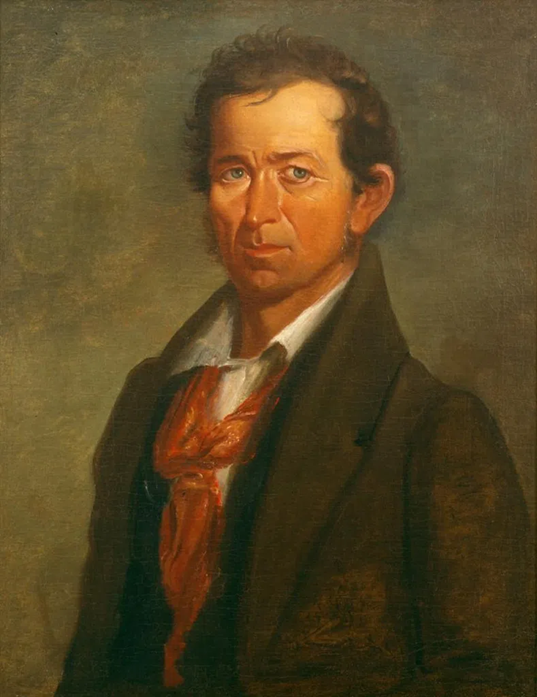![]()
By Benjamin Tumlinson
Columbia Historical Museum Board Member
One of the most celebrated heroes of the republic has ties to West Columbia. Erastus Smith is lauded in Texas history as a scout and spy, as well as a soldier and Texas Ranger. He was born April 19, 1787, in Dutchess County, New York. At age 11, he and his parents moved to Natchez, Miss. Smith made his first foray into Texas in his mid-20s and made Texas home in 1821. It is believed he came to Texas for his health after suffering an illness that caused him severe hearing loss earning him the nickname “Deaf” Smith.
In 1825, Smith was in Green DeWitt’s colony and settled what is now Gonzales (Access Genealogy, Biography of Deaf Smith). Smith moved to San Antonio de Bexar, where he met and married the Mexican widow Guadalupe Duran in 1828. During the initial stages of trouble between the colonists and the Mexican government, Smith tried to remain neutral. This changed while he was traveling back from a hunt when he was accosted by the Mexican Army. Eyewitnesses from the Texan Army picket guard claim he was struck over the head with a saber, causing him injury — and to lose his hat. Smith enlisted in the Texan Army the next day.
Smith earned his reputation as a trusted scout and spy early. He was with James Bowie and James Fannin at the Battle of Mission Concepcion, the first major skirmish with the Mexicans. Smith’s scouting report alerted the Texian Army of approaching Mexican troops, information that led to the Grass Fight on Nov. 26, 1835. The Texans repelled the Mexicans and captured 40 pack animals, only to discover that the packs’ contents contained grass. During the siege of Bexar, Smith guided Col. Francis Johnson’s men into town. On Dec. 8 he was wounded on top of the Veramendi Palace (Texas State Historical Association; Smith, Erastus [Deaf]) It was about this time that Smith moved his family to Columbia for safety.
After recovering, Smith became the courier for Col. William B. Travis at the Alamo. He carried Travis’ famed cry for assistance to Gen. Sam Houston. He and Henry Karnes were sent back to San Antonio to ascertain the fate of the defenders of the Alamo. He returned to Houston with Susanna Dickerson and her daughter along with the tragic news.
Smith was promoted to captain and began training recruits. Prior to the battle of San Jacinto, Smith and some comrades captured a Mexican courier who had vital information about the size and disposition of Santa Anna’s army. On the morning of April 21, 1836, Smith, and some trusted compatriots, disabled Vince’s Bridge. In his official battle report, Gen. Sam Houston stated his purpose in ordering the bridge destroyed was for “cutting off all possibility of escape.” (Texas State Historical Association; Vince’s Bridge) Santa Anna was trying to reach Gen. Vicente Filisola, his second-in-command, who had 2,500 troops nearby at Thompson’s Crossing on the Brazos River. (Texas State Historical Association, Vince’s Bridge) The destruction of the bridge prevented Santa Anna from quickly escaping and his capture resulted in Texas’ independence. Smith returned to the ranks and fought in the Battle of San Jacinto. After the battle he was sent by General Houston to overtake General Filisola and deliver to him orders from Santa Anna to retreat with his men from Texas soil. (sanjacinto-museum.org, (Smith, Erastus (Deaf)).
After the war, Smith returned to Columbia and his family for a short time. They eventually moved back to San Antonio where he served as a ranger captain. He led expeditions on the southern border, repelling Mexican forces that still claimed land west of the Nueces River. Smith stated that his objective was “to raise the flag of Independence on the spire of the Catholic Church at Laredo.” (sanjacinto-museum.org, (Smith, Erastus (Deaf)).
Shortly after this excursion, Smith moved to Richmond. He was struck by a sudden illness and died at the home of his friend, Randal Jones on Nov. 30, 1837. On hearing of his death, Houston wrote, “My Friend Deaf Smith, and my stay in darkest hour, Is no more!!! A man, more brave, and honest never, lived. His soul is with God, but his fame and his family, must command the care of His Country!”
On Dec. 18, 1837, the Baltimore Sun carried this tribute: “This singular individual was one of the few men whose names alone bear with them more respect than sounding titles. Major, colonel, general, sink into insignificance before the simple, ordinary name of Deaf Smith. That name is identified with the battlefields of Texas; his eulogy is inseparably interwoven with the most thrilling annals of our country, and will long yield to our traditionary narratives a peculiar interest.” (Houston, Dec. 2, 1837)

Image courtesy of the San Jacinto Museum of History

